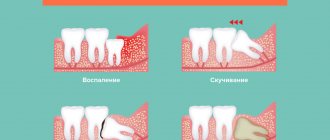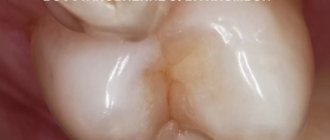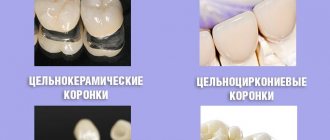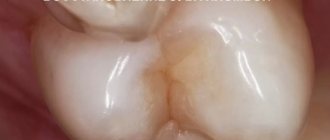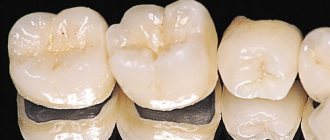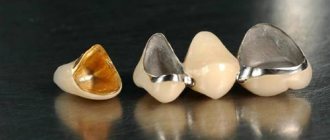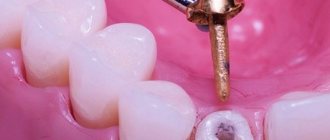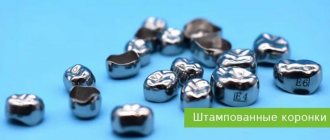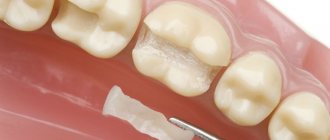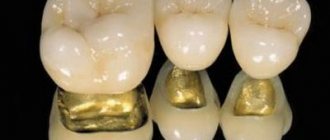Metal and plastic
These are inexpensive crowns that have been placed on the front teeth for decades.
The metal base was covered with an inert synthetic. But time has shown the conventional aesthetics of the structures - over time, the coating darkened and the metal became visible. After a couple of years, a painful replacement of the prosthesis was required. Today, metal-plastic crowns are cheap and can be used for the restoration of molars. But their aesthetic life is maximum 3 years. Therefore, this option is recommended as temporary. Before permanent prosthetics during implantation or in other cases when it is impossible to install a permanent prosthesis immediately after treatment.
Methods for preparing teeth for metal-ceramic crowns
In dentistry, various means are used to prepare teeth for metal-ceramic crowns:
- Laser. The pulses emanating from the device evaporate the thinnest layers of hard tissue (0.0003 mm). Then, using a water-air spray, microparticles of enamel and dentin are removed. During the procedure, tissues and instruments do not overheat, and due to the absence of irritation of nerve endings, the patient does not experience any discomfort. Since the tooth does not hurt, you can do without anesthesia.
- Diamond tipped burs. This option is called tunnel preparation of teeth for metal ceramics. Using this method, the dentist can clearly plan and control the process of stump formation. The work is very delicate and requires highly qualified specialists. If the technology is violated, there is a risk of dentin overheating. Due to insufficient anesthesia, the tooth may hurt.
- Ultrasound. As in the case of a laser, tooth turning under metal-ceramics takes place without overheating of hard tissues, chips and cracks. The best results can be achieved by using rotary and ultrasonic instruments together. The latter help to perform high-quality finishing for a reliable fit of the edges of the crown to the ledges.
- Air abrasive jet. A special mixture is applied to the tooth under pressure, which gradually, layer by layer, removes the enamel. This method of preparation for solid crowns or stamped crowns (rarely used in clinics today) does not cause discomfort and allows you to preserve the maximum amount of healthy dental tissue.
- Chemical substances. A special composition is applied to the teeth, which dissolves hard tissue in the required volume. Unlike other methods, this method takes quite a lot of time - from 30 to 60 minutes.
Zirconium dioxide and ceramics
Such dentures are flawless and are recommended for installation on the front teeth. The units are stronger than natural ones due to the stable zirconium frame, and the ceramic coating gives them a visual naturalness, ensuring correct light reflection.
But such a tooth crown is expensive. And it’s not always justified. Modern solid ceramics are close in strength to natural enamel. Therefore, in most cases, frameless ceramics, which are indistinguishable from natural units, are chosen for the restoration of the beauty area.
In addition, Cerec porcelain crowns for front teeth can be made within 1.5 hours; the price of this option is more affordable and its aesthetics are high. The artificial units created using innovative equipment will be flawless, you don’t need to get used to them - their parameters are calculated by a computer program taking into account the anatomical characteristics of a particular patient.
Porcelain crowns for front teeth
The main distinctive feature of porcelain crowns is that they do not contain metal impurities, so their use is especially justified if the patient is allergic to metal. Materials for porcelain crowns are special porcelain-based mixtures that are inert and therefore do not stain or irritate soft tissue.
Just a few years ago, in most cases, prosthetics with porcelain crowns were carried out in the anterior part of the jaw, since it was believed that such products were too fragile for chewing teeth, which bear heavy loads. Indeed, conventional porcelain crowns are more fragile compared to their metal counterparts, but the use of a zirconium dioxide frame made it possible to achieve the necessary strength and make it possible to use them in any area of the jaw. In general, the indications for use of porcelain crowns are almost the same as for other structures of a similar type.
Metal ceramics
If it is necessary to replace molars, ceramics will not be suitable; the material is too fragile and will not withstand the increased load. Therefore, it is more reasonable to install metal-ceramic or zirconium crowns on chewing teeth. The last segment is more expensive. Therefore, many patients choose a metal cast crown coated with ceramics.
Modern frames are made only by casting. This ensures a tight fit of the crown in the remains of the natural tooth, preventing the entry of pathogenic microflora into the tooth.
When are combined crowns installed?
Metal-ceramics can be installed if a large tooth crown is destroyed; the frame will protect the remains of the molars from excessive loads.
Metal ceramics are installed:
- For a real tooth with a healthy, strong root that has crumbled by 50% or more.
- As part of the bridge structure - crowns on the supporting teeth.
- As a final prosthesis on implants.
The option is quite worthy for maintaining the function of chewing teeth and helping to preserve the structure of periodontal tissues.
But in general, if a tooth is more than 50 percent damaged, it is more advisable to install a Cerec module, and the tooth restored in this way will serve you for many more years.
Making porcelain crowns
The production of porcelain crowns requires the presence of expensive equipment and experienced specialists on the staff of a clinic or dental laboratory. Today, two methods are used to produce such crowns - layer-by-layer application of porcelain mass and injection molding technology. The second method is considered more modern (as it provides the finished structure with greater strength) and is used in most dental laboratories. The production of a porcelain crown takes place in several stages.
Stage 1 - preparatory
Preparation of teeth for a porcelain crown and selection of color for the future prosthesis.
Stage 2 - taking an impression
The doctor takes impressions of the teeth, which are then sent to a dental laboratory.
Stage 3 - matrix production
Thin platinum foil is used as a mold for the future dental crown, which is placed on the model and filled with porcelain mass.
Stage 4 - firing
The crown goes through several stages of processing under the influence of high temperatures.
Stage 5 - product processing
The dental technician makes adjustments to the structure so that its shape and surface perfectly match the patient’s teeth. At the final stage, the finished structure is painted and glazed.
Advantages
Due to the metal base, combined crowns are stronger than real teeth. With proper care, their service life is 15 years
.
Additional advantages:
- They do not lose their shape or shade.
- Visually close to natural enamel. Therefore, they are invisible against the background of neighboring molars when laughing or talking.
- Reliable protection and functionality - you can safely chew your usual food.
- The risk of allergies is minimal (traditionally, up to 2% of people are sensitive to alloys).
When installed correctly, it adheres to the gum and tooth, protecting the units
Indications for the installation of porcelain crowns
The main indication for the installation of porcelain crowns is the aesthetic restoration of the front teeth:
· wedge-shaped defects and chips that cannot be eliminated using filling material;
Complete destruction of the dental crown;
· enamel hypoplasia;
Abnormalities in tooth color or shape;
· a pronounced change in the shade of tooth enamel that cannot be corrected using professional hygiene methods.
In addition, such designs are suitable for patients who are allergic to metal.
Manufacturing and installation of combined crowns
To put a metal-ceramic crown on your teeth (cost – 17,900 rubles / tooth), it will take 7-14 days
.
Manufacturing sequence:
- The tooth is prepared to the thickness of the crown.
- An impression is taken from which a cast crown is made.
- It is advisable to install temporary plastic protection on treated teeth.
- A metal frame is made and tried on.
- If adjustments are needed, they are made, and another fitting follows. When the artificial tooth fits, the metal is coated with ceramic.
- During installation, the tooth is covered with a protective compound, and the prosthesis is fixed with dental cement.
A nuance: the ceramics are applied in layers, each layer is baked in an oven under high temperature. Therefore, the coating is stable and securely attached to the metal base. Contact me at the dentist and we will decide what crown to put on the tooth in your case.
Other options for metal crowns:
But metal crowns for teeth can be made not only by casting. For example, there are so-called “stamped crowns”, which were widespread in the Soviet Union. Such crowns have many disadvantages, and are now used only in the most backward corners of our Motherland. Another option is metal crowns made using CAD/CAM technology, i.e. by milling method on a computer-controlled machine.
1) Stamped crowns –
In the Soviet Union, prosthetics were performed exclusively with metal crowns made by stamping. This method meant that each crown was stamped from a blank (metal sleeve). Such a sleeve was strung on special metal posts, which were shaped like the patient’s teeth.
Next, the dental technician tapped the sleeve with a hammer, giving it the shape of a tooth - after which the crown was sprayed. If it was necessary to make a bridge, the crowns were connected to each other by soldering. Unfortunately, it is worth noting that this antediluvian method of making crowns is still used in a number of regions of Russia.
Stamped crown after polishing –
Disadvantages of stamped crowns:
- The thin wall of the crown leads to its gradual “eating.”
- Stamped crowns do not fit tightly to the tooth in the neck area, which leads to saliva, food, and microorganisms getting under the crown - followed by rotting of the tooth under the crown.
- When making a bridge from stamped crowns, the following problems arise: → firstly, the prosthesis can break where the crowns are soldered to each other, → secondly, metals other than the metal from which the crowns themselves are made are used for soldering.
The latter means that in the humid environment of the oral cavity this will lead to the appearance of low-strength galvanic currents (the phenomenon of galvanosis). With prolonged exposure to the mucous membrane, this leads to the development of inflammation in it, disruption of the processes of keratinization of the epithelium, and also contributes to the development of leukoplakia. Therefore, in dentistry, they try not to use dissimilar metals for the manufacture of crowns and bridges.
Advantages of cast crowns over stamped ones:
- Quality, long service life - solid crowns are made from an individual impression taken from ground teeth.
In this case, the solid casting method makes it possible to produce crowns that will completely match the shape of the tooth and avoid saliva leaking under the crown, microorganisms and food debris. The service life of such crowns (subject to high-quality manufacturing) is 10 years or even more. To produce a high-quality solid crown, it is very important that the tooth is ground correctly (with a circular shoulder in the neck area). There are also options for preparing teeth for cast crowns without creating a ledge, but in this case it will be difficult to expect a long service life. In this case, the preparation of teeth for stamped crowns is always carried out without creating a ledge.
- Durability and reliability – for the manufacture of solid-cast bridges, soldering is not required, i.e. the design is one-piece and consists of a single metal alloy. This gives the structure strength and also does not lead to the occurrence of electro-chemical reactions (galvanosis). Accordingly, this significantly reduces the risk of diseases of the oral mucosa, as well as a constant unpleasant metallic taste.
2) Metal crowns using CAD/CAM technology –
CAD/CAM technology assumes that a crown or bridge will be made by milling on a computer-controlled machine.
To do this, an impression is also taken from the tooth ground for a crown, which is then digitized, and a model of the future artificial crown or bridge is created on a computer. Next, the digital profile of the crowns is transferred to a computer-controlled machine. Milling occurs without human intervention, and special blanks made of cobalt-chromium alloy (CoCr) are used as the material. And here again it is important that the dental laboratory at the clinic purchases only high-quality cobalt-chromium alloy blanks that do not contain beryllium and nickel. Such questions should be discussed with the dentist at a preliminary consultation, and normal doctors will be quite adequate in your awareness of such subtle aspects of prosthetics.
Metal bridge milling (CAD/CAM) –
The advantage of metal crowns milled using CAD/CAM technology lies in the much greater precision of their manufacture (compared to metal crowns made by casting). This is especially important in the area where the artificial crown is directly adjacent to the shoulder created when the tooth was prepared for the crown. This increases the reliability and service life of crowns and bridges.
3) Advantages of cast crowns over metal-ceramics –
Of course, it is not worth replacing the front teeth with solid crowns, because... They are not aesthetic at all. Moreover, this applies not only to the crowns themselves, but also to the gums around them. The fact is that a solid-cast crown goes under the gum by about 0.5 mm and, accordingly, this will lead to the fact that the metal will give the gum a gray or bluish color. Such gums look very ugly, although this will not be critical when replacing the chewing teeth with prosthetics.
It would seem that there are no advantages of solid-cast crowns over metal-ceramics, but they are still present. And this is not only lower cost. The advantages of cast crowns also include:
- Less amount of tooth preparation - the production of any crown is due to the fact that the tooth is first ground down to the thickness of the future crown (on average 1.5-2 mm on each side). So, for a solid-cast crown, the tooth is ground down much less than for a metal-ceramic crown. This is due to the fact that the thickness of a metal-ceramic crown is greater than the thickness of a solid cast crown. Preserving a larger volume of tooth tissue leads to an increase in its service life.
- Ease of manufacture, reliability - solid crowns are extremely simple to manufacture. Metal ceramics have a metal frame inside, which is lined with ceramics on the outside. The complexity of manufacturing metal-ceramics leads to a slight decrease in the reliability of the structure, for example, to the appearance of chips in the ceramics.
